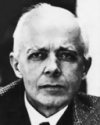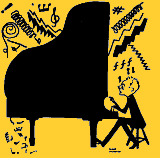
Bela Bartok
The music of Bela Bartok has a reputation for being difficult, dissonant, percussive, jarring, even ugly. It seemed to lack the tonal qualities of melodic music such as Rachmaninov's symphonies or the lush orchestral coloration of the impressionists like Debussy. It was rubbished by many critics of the time, and largely ignored by the public.
“If the reader were so rash as to purchase any of Bela Bartok's compositions, he would find that they each and all consist of unmeaning bunches of notes, apparently representing the composer promenading the keyboard in his boots. Some can be played better with the elbows, others with the flat of the hand. None require fingers to perform or ears to listen to” - wrote one critic.
Despite his growing international fame and recognition as an “important composer”, and his universal acclaim for his research on the folk music of Eastern Europe, Bartok's own compositions suffered the ignominy of neglect in the concert hall.

Caricature of Bartok
His reputation fed itself. Pianists and orchestras played up to the Bartok notoriety by performing his music as violently and savagely as they could.
There is even a caricature of Bartok from a New York publication dating from his first tour of the United States in 1928. Bartok sits at the piano serenely unaware of the machine-like cacaphony emerging from its depths.
It would seem that his is not music for the beginner or the faint-of-heart.
Yet this is a great shame. Bartok is certainly one of the most misunderstood composers of the twentieth century. He was a quiet, thoughtful man who set out to shock nobody. His major life's work was to catalog and preserve the folk music of Hungary, Romania and surrounding countries before they were lost to the progress of the world.
And within these melodies and rhythms was the inspiration and explanation for much of his own compositions. Here were the jaunty rhythms, unusual harmonies and driving pulsations of his works. They derive from those country dances and songs of daily life that Bartok encountered on his travels. Of course, all wrapped in Bartok's genius which encompassed the contrupuntal writing of Bach, the orchestral color of Richard Strauss and the biting wit of Stravinsky.
Concerto for Piano and Orchestra number 1
His three piano concertos span most of his creative styles. The first, dating from 1926, is the most difficult, and least melodic. The themes are reduced to a minimum number of notes, often a single, repeated note, octave spans or a simple rising scale. The orchestration likewise is reduced to its essence. In fact, in the second movement the string are absent, scored for piano, winds and percussion only. The finale is a fast frenzied dance.
The work is certainly dissonant and seemingly mechanical in parts (and was met with derision at its first US performance), but there is an underlying cohesion to it, brought together by the ever-present folk-like themes and rhythms.
Concerto for Piano and Orchestra number 2
Bartok's second piano concerto is from 1931. He wrote that his aim was a concerto “with fewer difficulties for the orchestra and more pleasing in its thematic material”. It was a much greater success than the first. Bartok himself premiered it in Frankfurt in 1933, his last performance in soon-to-be Nazi Germany.
While just as driving as the
First, the
Second has more expansive, recognisable themes. György Sandor plays it with the dance-like spirit that it was intended, rather than the motoric brutality that is the Bartok cliché.
The first movement is again without strings, the brass, winds and percussion carrying it along. The second movement starts threatening and slow with rising tension giving way to a spectacular bring-the-house-down climax in the finale.
Concerto for Piano and Orchestra number 3
This is the undisputed jewel in the crown. Bartok's final piano concerto ranks with the best of the twentieth century, and indeed of any era.
It dates from 1945, Bartok's last year. He had fled Nazi Europe, and was living with his wife Marta in New York but as outsiders, desperately homesick for Hungary and not really fitting in to New York life. He was disgusted with Hungary's aligning itself with fascist Germany and had banned any performance of his works there. As a result, he was impoverished, unable to collect royalties from his German publisher. He was also sick. The leukemia that was eventually to kill him had taken hold.
Yet this is a work full of joy. The first movement is witty and playful, the final movement is happy and triumphant, with a complex fugue in its center.
But the central movement is magic. This is a movement entitled
Andante religioso, this from an avowed atheist. Never before had he used this term. It starts quietly, like a prayer, builds in intensity and quickens to a toccata, then falls back content and accepting. It is one of the most peaceful and beautiful pieces of music ever written, from a man who knows he is about to die.
Bartok died on September 26, 1945, leaving the final 17 bars unfinished (they were completed by his student Tibor Serly).
The pianist here, György Sandor, was a close friend of Bartok's and visited him almost daily during his final months. He has won much acclaim for recording the complete piano works of Bartok. Having heard Bartok himself play the first two concertos, and premiering the third, Sandor brings these works back to Bartok's original intention. Forceful but not violent, dance-like and folk-inspired. And finally serene and uplifting.
There is a large crowd of music-lovers who are Bartok-haters. I propose this CD to change their views, a journey from the most difficult and to the most beautiful of music.
Please support Good-Music-Guide.com
by purchasing this CD using this link.

Track Listing
Bela Bartok
The Three Piano Concertos
Gyorgy Sandor, piano
Hungarian State Orchestra
Adam Fischer
1989 recording
Concerto for Piano and Orchestra no.1
- Allegro moderato; Allegro
- Andante
- Allegro molto
Concerto for Piano and Orchestra no.2
- Allegro
- Adagio; Presto; Adagio
- Allegro molto
Concerto for Piano and Orchestra no.3
- Allegretto
- Adagio religioso
- Allegro vivace